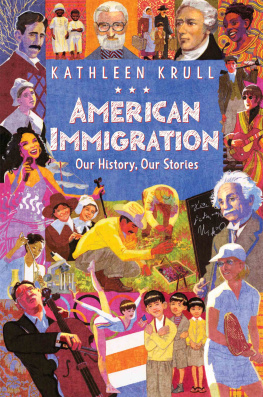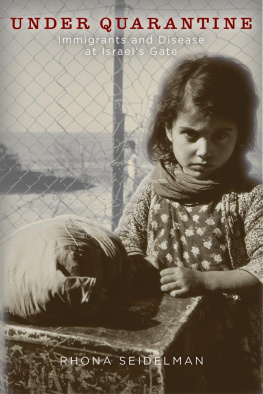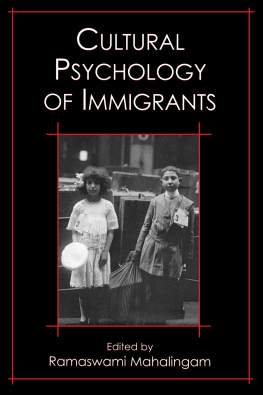First published in 1963 by Prentice-Hall, Inc.
Published 2006 by Transaction Publishers
Published 2017 by Routledge
2 Park Square, Milton Park, Abingdon, Oxon OX14 4RN
711 Third Avenue, New York, NY 10017, USA
Routledge is an imprint of the Taylor & Francis Group, an informa business
New material this edition Copyright 2006 by Taylor & Francis.
All rights reserved. No part of this book may be reprinted or reproduced or utilised in any form or by any electronic, mechanical, or other means, now known or hereafter invented, including photocopying and recording, or in any information storage or retrieval system, without permission in writing from the publishers.
Notice:
Product or corporate names may be trademarks or registered trademarks, and are used only for identification and explanation without intent to infringe.
Library of Congress Catalog Number: 2005044777
Library of Congress Cataloging-in-Publication Data
Shuval, Judith T.
Immigrants on the threshold / Judith T. Shuval ; with a new preface by Alex Weingrod and a new introduction by the author.
p. cm.
Originally published: New York : Atherton Press, c1963. (The Atherton Press behavioral science series)
Includes bibliographical references and index.
ISBN 1-4128-0575-9 (pbk. : alk. paper)
1. ImmigrantsIsrael. 2. IsraelEmigration and immigration. 3.
Social integrationIsrael. 4. EthnicityIsrael. I. Title. II. Atherton Press
behavioral science series.
JV8749.S53 2006
304.85694dc22
2005044777
ISBN 13: 978-1-4128-0575-9 (pbk)
Israeli Ethnicity: Looking Back, Looking Ahead
Alex Weingrod
Thresholds are beginnings, or perhaps even prior to beginnings, and Judith Shuvals finely developed study of the attitudes and experiences of Jewish immigrants as they entered Israel takes us back (as she writes) to another time and another place. This is part of the books importance and appeal. Caught up by the perplexing events in the present, looking back to the threshold more than a half century earliercan lend a sense of perspective, a kind of accounting of where Israeli society was then and where it is today.
The Israel that Shuval describes in this book has changed enormously. In 1949-1950, the time when her study was undertaken, Israel was a small, poor, ambitious state and society seeking to establish itself, while at the same time straining to accommodate the tens of thousands of Jewish immigrants then arriving from dozens of different countries. The seemingly invisible Arab minority (invisible to the Jews, that is) was then sunk in defeat and despair, and the Jewish majority was busily building traditions and institutions that were pointedly secular and socialist. Now, a half-century after the threshold, practically everything looks different. The Israeli population has grown to well over six million persons, Tel Aviv has become the vortex for an urbanized country that is tightly linked into the global economy and technology, periodic wars and intifadas have seared the relationships between the Jewish majority and the increasingly militant Palestinian-Arab minority, and, culturally and politically, the society has become more stridently nationalist while also deeply divided between opposed ideological, religious, and other groups. With all of the chaos and tensions of the founding threshold period, the present appears no less filled with divisions and dangers.
The immigrants that Shuval writes about have also changed. It is fair to assume that some of her 1949-1950 informants are still alive and active, and among these many are the parents and grandparents of two new Israeli generations. Over time, members of these three generations have certainly become more Israeli: They speak and read Hebrew, the children and grandchildren attend a wide variety of different schools, most have or will serve in the army, they celebrate the yearly round of national and religious holidays, and they also are employed in various trades, vocations, and professions, vote in repeated elections, and so forth. At the same time, in many ways they also differ from one another: They live in different places, have significantly different incomes, some are ultra-Orthodox religious and others are secular, they have different political ideologies and practice different lifestyles, and much, much more.
Ethnicity is another real or potential dimension of difference among Israelis. How could this not be the case? The Jewish immigrants that Shuval studied came from more than twenty different countries, ranging around the globe from Libya and Morocco to Poland and Yugoslavia (, p. 31). Moreover, throughout her analysis Shuval emphasizes country-of-origin ethnicity: As she puts it, One of the most striking impressions to emerge from the study is the generally high salience of the ethnic group during the period under discussion. There was hardly a problem in which differential ethnic patterns of attitude and behavior did not emerge (p.178). While still on the threshold, as it were, the place or country that one came from made a great deal of difference.
This poses a tantalizing and important set of questions. To what extent, and in what ways, may country-of-origin ethnicity continue to be significant among second and third generation Israelis? Is ethnicity an important feature of their everyday life, or has its salience waned with time and a changing social system? Has Israeli society become multicultural, as is sometimes claimed, or is it still relatively closed and dominated by the same social strata? Exploring these issues helps to illuminate the broad social contexts of Israeli life, and in this brief preface I want to sketch ways in which ethnicity continues to be a meaningful marker and potent force.
Who is Ethnic, Why, and What Difference Does it Make?
Social categories of differentiation are, as we have come to know, social constructions that may shift and change over time. For example, how persons are classified in a national census, or the ways in which the media refer to individuals, are neither fixed nor objective, but rather categories constructed by the state, or by various groups of persons, in particular historical moments and social contexts. What terms or concepts have been used to categorize country-of-origin ethnicity?
Although the range of difference has not been very wide, there is no uniformity to the terms according to which immigrants to Israel have been categorized. The studies published in the 1950s and 1960s used a number of different terms. For example, the Israeli census sometimes listed immigrants by their specific country of origin, but census publications usually bunched them together into European on the one hand, and Asia-Africa on the other. This division is, of course, broad and arbitrary: European includes both Yugoslavia and Germany, and Asia-Africa ranges between India, Libya, and Iraq. Quite a range! Sociological and anthropological studies published during this period used somewhat different categories. In his 1954 The Absorption of Immigrants, Eisenstadt distinguishes between European and Oriental Jews, and he continued to use this classification in later publications. Eisenstadts categories seem appropriate in Hebrew, but they are less successfull in English. Why Oriental? To my own American ear, the term Oriental conjures up images of persons who are Chinese or Japanese, entirely different from the Iraqi or Tunisian Jews then arriving in Israel. Some years later, when I wrote a short book on Israeli ethnicity, I choose to categorize immigrants as Europeans and Middle Easterners. This too was problematic since the term Middle Eastern did not quite stretch to include North Africans or the Jews of India, yet it seemed more appropriate then Orientals.







